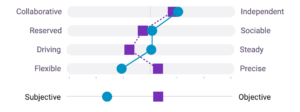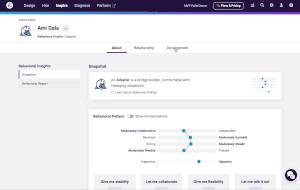Using the Coaching Guide
Managers and coaches aren’t one and the same. Being a manager is more directive and transactional. Managers oversee the work of their employees, create plans, and direct their employees. They identify needs and fix problems to keep projects moving so the business can achieve its goals.
Coaches are more consultative and employee-focused. They focus on asking questions to help an employee uncover the root of a problem and come up with an action plan themselves, rather than telling the employee the plan to follow. They then encourage and support the employee as they navigate the problem and solution themselves.
A good manager needs to know when to fill which role. A great manager knows which tools to use to help them along the way. The Coaching Guide is one of those tools.
Manager
Directive
Org/team-focused
Identifies problems
Creates action plans
Oversees work
Coach
Consultative
Employee-focused
Helps employee identify problems
Helps employee create action plans
Supports work
When should I use the Coaching Guide?
We all benefit from learning how to stretch our unique behavioral strengths and are asked or required to do so frequently, depending on what is going on in the workplace. Here are some places we see as the most valuable spots to use the Coaching Guide:
- During onboarding
- In 1:1 meetings
- For training and development
- While setting goals
How does the coaching guide work?
The Coaching Guide compares an employee’s behavioral pattern to the job target set for a specific position. It fills the gaps between what’s most comfortable to the employee (their Behavioral Pattern) and what their role requires (the Job Target). This can be used for professional development conversations for those looking to progress in their careers as well as in performance conversations where someone may be struggling in their role.
These conversations lead to opportunities for:
- The manager to see an employee’s behavioral style compared to a certain job.
- The manager and the employee to talk about whether a Job Target needs to be adjusted in any way.
- The manager to see what an employee needs and how their own behavioral profile will need to flex in order to support those needs.
1. Professional development
All managers are, at some level, responsible for building career paths for those on their team. When an employee expresses a desire to move into a different position, you can use the Coaching Guide to compare their Behavioral Assessment (BA) results to the Job Target for the role they’re interested in.
From there, you can having coaching conversations around how they may need to adjust and stretch their behaviors in that role as part of their professional growth and development–and if they even want to. This is a great way for you – and for the employee – to align on what the job change may mean for them, the team, and the organization. This also provides the manager and employee an opportunity identify areas where the employee needs support, so the manager can coach and upskill them in preparation for the new role.
Let’s say, for example, you have an employee in a Sales role who would like to become a manager. Below, you see the employee’s pattern as well as the Job Target for the Sales Manager role.

In the example above, the employee’s Dominance (A) and Patience (C) are different from that of the Job Target. They’re typically more collaborative and steady than they might need to be in the Sales Manager role. This means there are areas of the job that might take them out of their comfort zone.
To be successful in this role, this employee might need to embrace some discomfort that could come from decisions they make or decisions that are made that they need to communicate. Consider sharing best practices or resources around having difficult conversations. They also might need to solve problems more independently than they’re used to. Often, they’ll need strong coaching and reassurance from their manager and other managers and leaders in the organization.
Another area this employee might experience some discomfort is in the pace of the job itself. They currently prefer a calm and steady pace in their day-to-day work. As a manger, that role requires an individual to work on a variety of tasks, often at a faster pace. They may need help prioritizing their new workload and may have more questions when changes occur.
Identifying this now will help everyone understand what is expected so that, if this employee moves into the new role, they and their manager are aligned on what the employee needs and what the manager expects.
2. Performance
If there are opportunities for improved performance for an employee, leverage the Coaching Guide to generate questions to help them adjust their natural behaviors to be a closer match to the ideal behavioral target set out for their current role. A data-driven approach can provide the insights to address and tackle them.
Using people data and PI’s tools, you can tailor your leadership to set your team – and each individual on your team – up for success. Coaching encourages the personal and professional development of your team, because you believe that when they’re empowered, the entire organization wins.
Coaching conversation reminders
Remember, these tools are here to provide helpful data points. Nothing replaces having a conversation with this employee to align on what the data shows and how the employee feels. They could have great insight to where the Job Target may be missing the mark or how their behavioral profile could benefit the team they’d be managing – and the organization overall – to be successful.
- Let the employee drive the conversation.
- Practice active listening and confirm the things you’re hearing with something like, “Does that sound accurate?” “Am I on track?” or “Are we aligned so far?”
- Confirm that the employee agrees with the Job Target they’re being compared to.
- Remove any bias you may have about a person or their career goals.
Helpful tools for managers in PI Inspire
Before you have a conversation with an employee, it’s helpful to:
Manager self-awareness is vital to effective coaching conversations. When you’re self-aware, it means you understand your own natural behavioral tendencies.
It also means you have the powerful ability to adapt your leadership to the needs of others. When you do this successfully, you can motivate and get the best out of your team members.
TIP: Be sure to review the Management Style section of the report.
Understanding how someone is wired to think, work, and communicate gives you the information you need to have coaching conversations. Identify exactly what drives your employee.
Every person is unique, and your leadership should be tailored to make sure you’re getting the most out of each person on your team.
TIP: Consider what they need to succeed and how you might be a blocker or successful in leading them.
Different team members need to be managed in different ways. Compare your behavioral traits, see your strengths and caution areas, learn how to work well together, and get recommendations on how to improve communication and address conflict.

The Management Skills Guide is designed to help you become a more empathetic and self-aware manager. It includes a description of your unique behavioral strengths, along with potential caution areas. Use the coaching tips to address those cautions and elevate your natural leadership style.

Using behavioral data to understand how well you’re motivating someone can be very powerful. Use our management tips to see what your employee needs and how to best interact with them.

To inform us of a typo or other error, click here. To request a new feature, click here.


